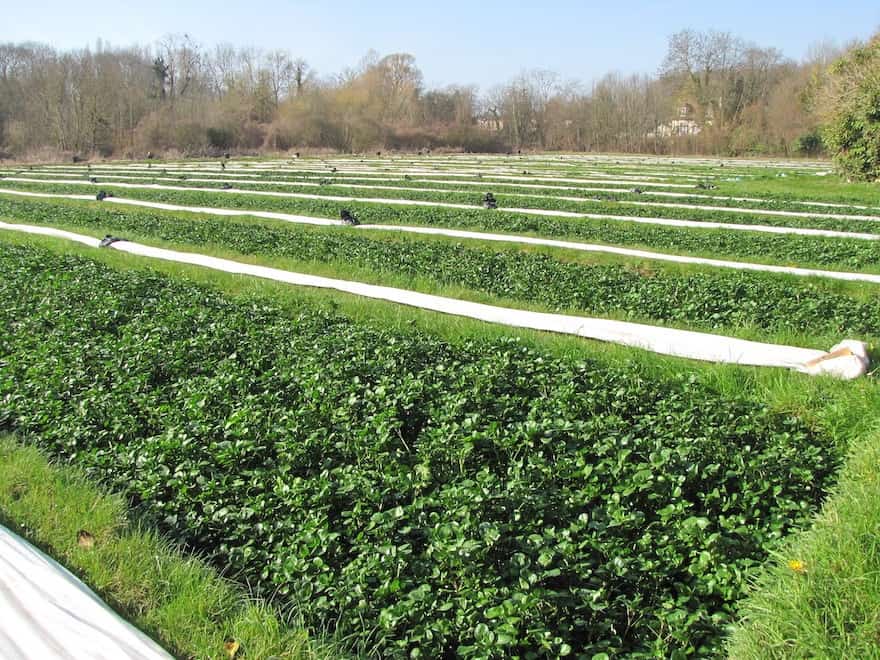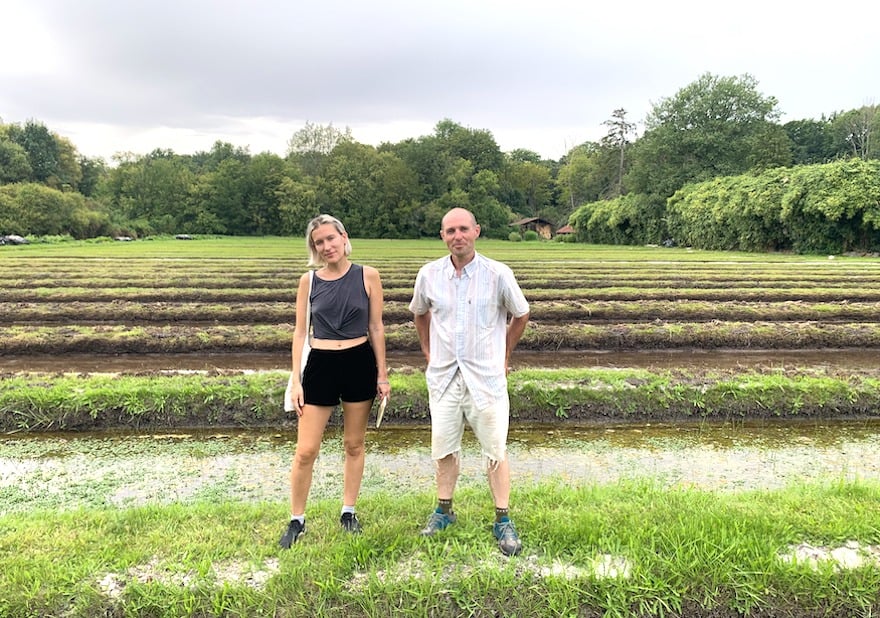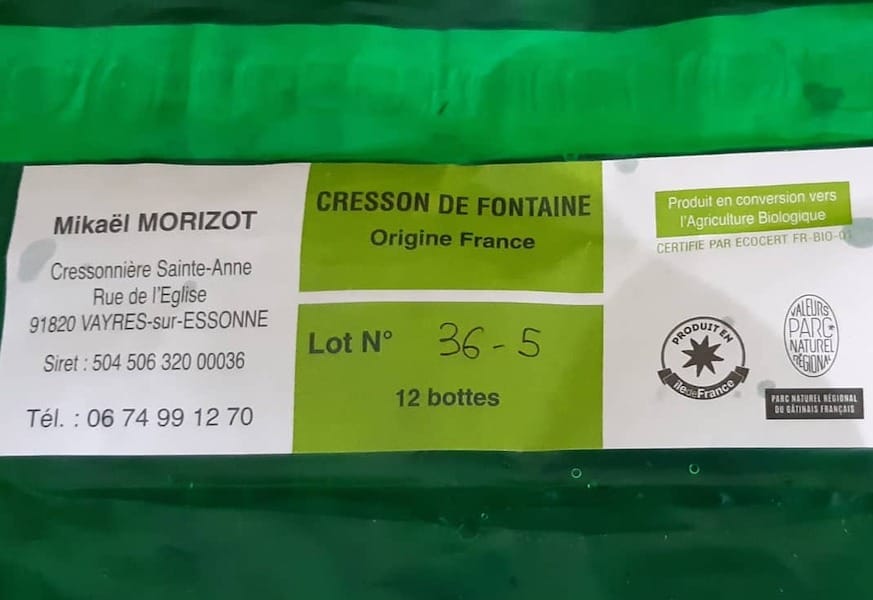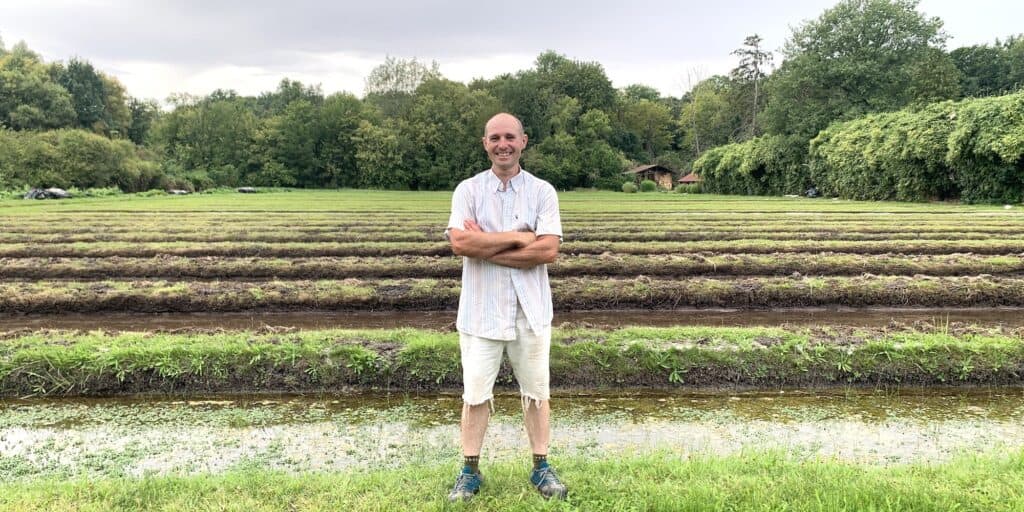WATERCRESS MEMO
✓ Watercress, also known as fountain cress, is a semi-aquatic plant that grows thanks to small roots that extract nutrients from the bottom of the water
✓ It has been consumed since Antiquity for its taste qualities but also for its nutritional richness and medicinal virtues
✓ Particularly rich in antioxidants, it protects the eyes, strengthens the bones, helps regulate blood sugar, and is believed to have anti-cancer activity
✓ It is mainly found in Europe and Japan. 40% of French production comes from Essonne
The first watercress farm in Essonne
A lovely undergrowth near Vayres-sur-Essonne, in the south of the department, serves as a setting for the watercress farm where we are welcomed by Mikaël. Historically, there was a washhouse at this location, remnants of which can still be seen. There is a requirement when you want to cultivate watercress: water! Indeed, a spring flows here, which gave its name to the watercress farm: Sainte Anne.
We are in the first watercress farm in Essonne, founded in 1854 for Louis Doublet. Mikaël’s family took it over in 1984. He previously worked in an environmental study office. During his many missions for water management in Normandy, he witnessed the increasingly excessive conversion of agricultural and natural lands into housing estates and commercial areas.

His family history (his great-grandfather was already a watercress grower!), his passion for watercress, the work of the land, and the environment finally convinced him to take over the operation previously managed by his uncle. When the latter retired, he thus resumed his activity, becoming the fourth generation of watercress grower in the family.
Today, the Sainte-Anne watercress farm is transitioning to organic farming and is distinguished by the Valeurs Parc naturel régional label (which ensures that a crop is part of a sustainable development approach) and is produced in Île-de-France. Rhubarb is also cultivated there.
Mikaël produces about 40,000 bunches of watercress per year and supplies AMAPs, the Rungis market, curious visitors who stop by, and even the Michelin-starred chef Alain Passard!
Normandy is the historical home of watercress in France. In Oise at the beginning of the 19th century, Joseph Marie Etienne Cardon developed the cultivation of fountain watercress. Then it was Essonne’s turn. Currently, watercress in Essonne is cultivated on about 15 hectares. Other watercress spots are found in Oise, Nord-Pas de Calais, Haute Normandie, Lyonnais, and near Agen for the largest.
In the 1960s, the liver fluke, a parasite, caused many farms to decline. While up to 100 producers were growing watercress in Essonne in the 1930s, there are now 25.

Also read Watercress, the antioxidant semi-aquatic plant
Today, supported by studies, we are rediscovering the health benefits of watercress. It is part of the Brassicaceae family, like cabbage and maca, and as such is particularly well-endowed with antioxidants. This is why it is recommended to eat it as fresh as possible, directly from the producer 🙂
The cultivation of watercress, from ditches to Rungis

Mikaël starts by showing us his spring. It’s from here that he draws the water that feeds the watercress ditches on his farm, which are comb-structured. The water comes in and out through a feeding ditch that runs alongside the cultivation ditches. Watercress acts as a purifier; for its development, it cleans the nitrates in the water by converting them into gaseous nitrogen! A beautiful and majestic bamboo hedge protects the watercress from the north winds.
It’s early August, and the watercress has just been sown. It will be harvested from September to May, in the 36 pools that make up the 5500 square meters of the farm. Mikaël does all the harvesting by himself, sometimes with the help of his father. It is a difficult job: you always have to be bent over the water to pick the bunches and take care of them. Mikaël assures us he has a good osteopath 🙂

“In the past, people would kneel on a board; today we use snowshoes to avoid damaging the watercress or the sandy bottom, and we harvest it with a knife”
When he harvests the watercress, he directly makes bunches. He remembers the gesture well! Each bunch weighs about 300 g. We observe the leaves, some of which are a beautiful purple-green. His father and he have isolated a variety with purple pigmentation, the purple watercress. More aesthetic (it is very popular with chefs) and richer in antioxidants. The family variety was already a beautiful dark green.

At the end of the season, we let the stems grow, and harvest the seeds from the flowers. These are true farm seeds, and Mikaël masters the entire process. He mixes them with Fontainebleau sand, then sows the seeds by broadcasting for good seed distribution, on a moistened ditch bottom.
As for how to enjoy it, he gives us plenty of inspiring ideas. Watercress pesto, lemon sorbet, watercress, a strawberry orange watercress smoothie… “The best way to enjoy watercress is not the eternal soup, but in a salad. You have to dare to pair it: watercress, pear, beetroot for example.”
Three times a week, Mikaël delivers his bunches of watercress to Rungis at 3 a.m. To follow his daily life as a watercress grower, visit his Instagram account!
The conversion to organic farming

Like many environmentally conscious farmers who are committed to offering the best possible foods for both health and taste, Mikaël has closely considered the possibility of converting to organic farming. Despite the economic challenges it presents at the start and the changes in skills and techniques required for the transition, he embarked on the journey last year.
So far, his production has lost 25% in yield, but he is persevering. “It’s a hard job, but a valuable product,” he tells us.

Making the transition to organic farming requires many changes:
- Nourishing the soil with organic and mineral fertilizers
- Using natural pesticides: nettle manure and a garlic oil extract
- Applying homeopathic remedies adapted to agriculture
- Using mulching sheets to smother remaining watercress after harvest and clean the ditches
This conversion has had an immediately visible effect: the proliferation of micro-fauna in the ditches: amphipods, woodlice, caddies, mayflies… And this is good news because these insects and other crustaceans are excellent bio-indicators.

The presence of amphipods, a type of freshwater shrimp, for example, indicates good quality and purity of the water. This animal is often used to determine the pollution level of a watercourse: if it’s polluted, the amphipods stop feeding and reproducing. Mikaël takes some moss from a ditch: it’s swarming!
The flip side of all these efforts is that he can already increase the price of his watercress, going from €1.30 to €1.80 a bunch.
Mikaël didn’t just give us a tour of the property, he also spoke at length about the history of watercress in France, supported by documents and archival photos! Passionate and generous, he turns his love for nature into a daily battle 🌳 🌳 🌳



